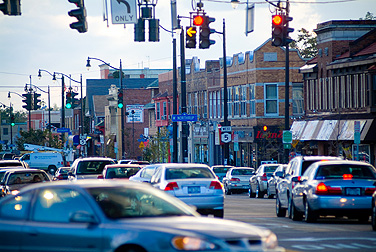News
‘Green routing’ can cut car emissions

Through computer simulations, UB researchers found that “green routing” can help drivers reduce fuel consumption without significantly increasing travel time.
-
 Print
Print -
 Comments
Comments
-

Transportation systems expert Adel Sadek says “green routing” is an easy way to significantly reduce carbon monoxide emissions that can be implemented today. Photo: DOUGLAS LEVERE
The path of least emissions may not always be the fastest way to drive somewhere. But according to new UB research, it’s possible for drivers to cut their tailpipe emissions without significantly slowing travel time.
In detailed, computer simulations of traffic in upstate New York’s Buffalo Niagara region, UB researchers Adel Sadek and Liya Guo found that green routing could reduce overall emissions of carbon monoxide by 27 percent for area drivers, while increasing the length of trips by an average of just 11 percent.
In many cases, simple changes yielded great gains.
Funneling cars along surface streets instead of freeways helped to limit fuel consumption, for instance. Intelligently targeting travelers was another strategy that worked: Rerouting just one fifth of drivers—those who would benefit most from a new path—reduced regional emissions by about 20 percent.
Sadek, a transportation systems expert, says one reason green routing is appealing is because it’s a strategy that consumers and transportation agencies could start using today.
“We’re not talking about replacing all vehicles with hybrid cars or transforming to a hydrogen-fuel economy—that would take time to implement,” explains Sadek, an associate professor of civil, structural and environmental engineering. “But this idea, green routing, we could implement it now.”
In the near future, GPS navigation systems and online maps could play an important role in promoting green routing, Sadek says. Specifically, these systems and programs could use transportation research to give drivers the option of choosing an environmentally friendly route instead of the shortest route.
Sadek and Guo, a PhD candidate, presented their research on green routing at the 18th World Congress on Intelligent Transportation Systems in October.
In the UB study on green routing, the researchers tied together two computer models commonly known as “MOVES” and “TRANSIMS.”
The Motor Vehicle Emission Simulator (MOVES), created by the Environmental Protection Agency, estimates emissions. The Transportation Analysis and Simulation System (TRANSIMS) simulates traffic in great detail, taking into account such information as the location and pattern of signals, the grade of the road and the trips people take at different times of day.
After incorporating Buffalo-specific data into TRANSIMS, Sadek and Guo ran a number of simulations, rerouting travelers in new ways each time.
After running the models numerous times, the researchers reached a “green-user equilibrium”—a traffic pattern where all drivers are traveling along optimal routes. With the system in equilibrium, moving a commuter from one path to another would increase a user’s overall emissions by creating more congestion or sparking another problem.
The simulations were part of a broader study Sadek is conducting on evaluating the likely environmental benefits of green routing in the region. His project is one of seven that the U.S. Department of Transportation has funded through a Broad Agency Announcement that aims to leverage intelligent transportation systems to reduce the environmental impact of transportation.

Reader Comments